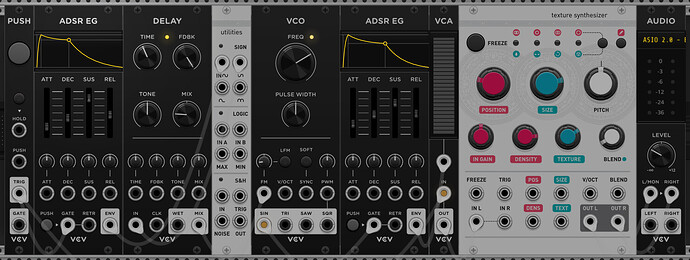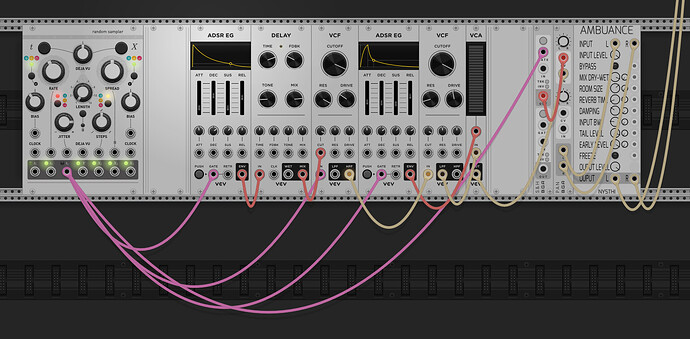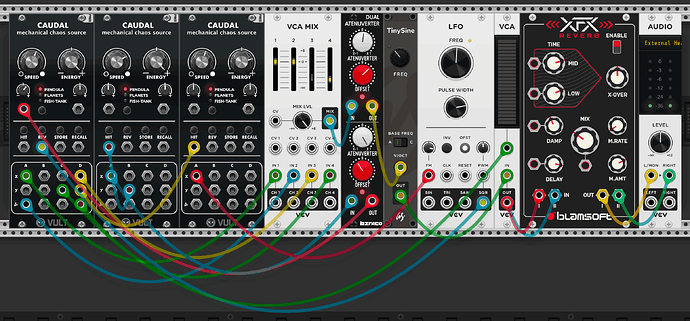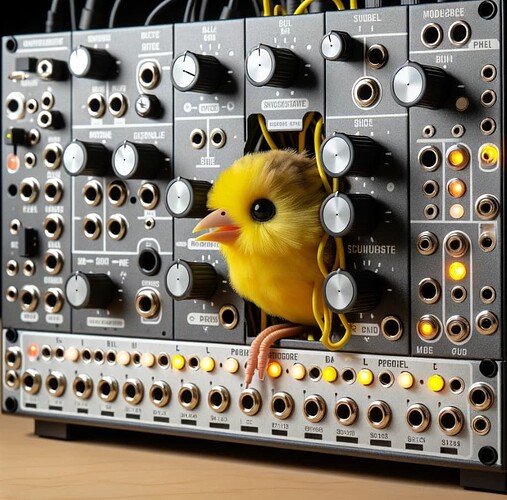Trying to do an assignemnt for college requiring a forest ambience and an anthropomorphic bird. I’ve had trouble replicating birdsong in a satisfactory way. It must be made using only the base VCV modules, any advice on how to approach this? Thanks.
Check this one:
a starting point
this patch is not for birds only, but frogs and other stuff
play a little bit with the knobs, of course if you are a beginner you will learn nothing from this
some really good stuff of course on youtube, learning is not immediate but the results are way different ![]()
a simple kinda wind can be done with noises and formant filters, try putting different sources into a mixer and pseudo-randomize the levels
For the…

… I would start by sending a gate/trigger into a filter with high resonance. ADSR into its cutoff and then vca.
For what it’s worth, some songbirds can produce two sounds independently, one from each side of their syrinx: Syrinx (bird anatomy) - Wikipedia ![]()
My favourite patch (not mine) from March 2021
Bird.vcv (2.3 KB)
I can’t not jump on these challenges when they present themselves ![]() I don’t want to have done that assignment for you if you’d like to figure things out for yourself - behind here is what I’ve come up with:
I don’t want to have done that assignment for you if you’d like to figure things out for yourself - behind here is what I’ve come up with:
I have always been fascinated by that bird ability.
There was one time in high school when I had some congestion in my nasal passages, and somehow it was creating its own vibrations when I hummed. So for a brief moment I was able to produce two tones at once. It was pretty wild.
super patch! and how much I like this reverb…always been one of my favourites in Rack!
About that…
I guess most of us at some point have heard about Throat singing, where a human can produce two tones/notes at the same time. Specifically Tuvan/Mongolian throat singing. Throat singing - Wikipedia
Some people can take this polyphonic overtone singing to musical extremes. Check out Anna-Maria Hefele demonstrating and explaining/visualizing her extraordinary techniques.
polyphonic overtone singing - explained visually by Anna-Maria Hefele
And a shorter version for those with a limited attention span ![]()
Here’s a patch/sketch that brings some ‘Life’ to VCV Rack that I remembered I had created at some point in the past. Kwurqx - Life.vcv (9.9 KB)
You could use some of the bird/animal/creature sounds/techniques in that patch as an example.
Apparently I didnt bother to have the Rampage Envelope Generators (loop mode) triggered automatically at start up. So, they need manual triggering in this patch.
Hi! I know this is not recent, but I wanted to make a patch like this, was looking for examples, just found this one and I love it, but I’m trying to customize it and I’m having trouble as I never used Caudal before. When I try to change the configuration and connections it never sounds as natural as in the original version. Do you have any tips about how to use Caudal and connect different instances in order to produce this kind of sound? What’s the most important aspect about the modulation in this patch? Cheers!
Sorry for the late reply. I don’t visit this forum as often as I used to.
Caudal has models to simulate four related things moving about, like the four parts of a pendulum swinging around, and so on. See https://www.vult-dsp.com/caudal for a bit more information on that. That’s what to keep in mind. The A, B, C and D outputs represent the X and Y positions of each of those four parts.
One way of learning what Caudal does is to hook it up to VCV Scope, set the scope to quite a long “history” time, and watch what happens when you mess about with the Caudal controls.
Attached are two patches that have the four Caudal outputs A, B, C and D hooked up to four Scopes in X/Y mode, so you can get an idea of what’s going on. (One patch uses the free version of Caudal, the other uses the paid version. Both do the same thing, I’m just not sure which version you’ll have installed.)
caudalfree4scopes.vcv (1.1 KB)
caudalpaid4scopes.vcv (1.1 KB)
For example, in Pendula mode, you’ll see that B is more “complex” than A, C more complex than B, and D more complex than C. Switch to the other modes to get an idea of what they do.
I suppose also have things modulating other things, use VCAs or attenuators to affect modulation levels, etc. Just play and see what happens. ![]()
Edit: I suppose another thing is maybe record some birds using https://merlin.allaboutbirds.org, look at the sonograms of the bird recordings you make and use that to inform what you are going for.
Wow thank you!
Not a VCV Fundamental module (if that’s what you meant) but how about starting with Bogaudio’s CHIRP module?
Run it with something like a 3-channel sequencer CV outputs for FREQ 1, FREQ 2, & TIME, and use the EOC to advance to the next step and re-trigger the chirp. Might need an OR gate to bootstrap the sequencer? Also get CV-MAP to moderately randomize the notes.







